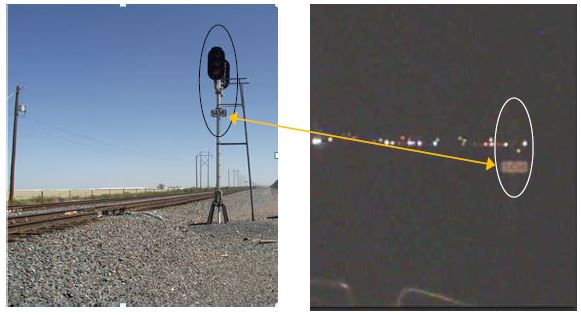Executive Summary
On September 25, 2013, at 4:17 a.m. central daylight time, BNSF Railway
(BNSF) eastbound train BLACWSP223A (7891 East) struck the rear end of
standing BNSF train SLHTLPC223A (6746 East) on main track no. 2 near
Amarillo, Texas. Several cars from 7891 East derailed and fell across
the adjacent track, main track no. 1. Approaching BNSF westbound train
ZWSPSBD724L (6943 West) struck the derailed cars.
The engineer and the conductor of train 7891 East recalled passing signals warning them of the train ahead. However, the signal at milepost 543.65 was not lit because the bulb had burned out (also known as a dark or improperly displayed signal).
Had the bulb not been burned out, the signal would have displayed a red aspect, which would have required them to stop the train before proceeding at restricted speed. When they passed this signal, neither crewmember noticed that the signal was dark. A dark signal also required the crew to stop the train before proceeding at restricted speed.
The engineer stated that he thought the dim (low-beam) headlight from the rear end locomotive helper unit of 6746 East was an approaching train on the adjacent track. The conductor thought the headlight had a yellow cast to it and was a wayside signal. Neither crewmember thought the headlight was on the rear of a standing train.
Five of the six involved train crewmembers received injuries and were hospitalized. The weather was clear with 10-mile visibility, and the temperature was 59°F. Estimated damage was $4.4 million.
The National Transportation Safety Board (NTSB) determines that the probable cause of the accident was the failure of the 7891 East train crew to comply with the requirement to stop and proceed at restricted speed when encountering a dark or improperly displayed signal.
Contributing to the accident was the use of a dim headlight to indicate the rear end of the standing train, which the 7891 East engineer misinterpreted as the headlight of an opposing train on the adjacent track and the conductor misinterpreted as an upcoming yellow signal. Also contributing to the accident was the lack of a positive train control system that could have prevented the accident.
The engineer and the conductor of train 7891 East recalled passing signals warning them of the train ahead. However, the signal at milepost 543.65 was not lit because the bulb had burned out (also known as a dark or improperly displayed signal).
Had the bulb not been burned out, the signal would have displayed a red aspect, which would have required them to stop the train before proceeding at restricted speed. When they passed this signal, neither crewmember noticed that the signal was dark. A dark signal also required the crew to stop the train before proceeding at restricted speed.
The engineer stated that he thought the dim (low-beam) headlight from the rear end locomotive helper unit of 6746 East was an approaching train on the adjacent track. The conductor thought the headlight had a yellow cast to it and was a wayside signal. Neither crewmember thought the headlight was on the rear of a standing train.
Five of the six involved train crewmembers received injuries and were hospitalized. The weather was clear with 10-mile visibility, and the temperature was 59°F. Estimated damage was $4.4 million.
The National Transportation Safety Board (NTSB) determines that the probable cause of the accident was the failure of the 7891 East train crew to comply with the requirement to stop and proceed at restricted speed when encountering a dark or improperly displayed signal.
Contributing to the accident was the use of a dim headlight to indicate the rear end of the standing train, which the 7891 East engineer misinterpreted as the headlight of an opposing train on the adjacent track and the conductor misinterpreted as an upcoming yellow signal. Also contributing to the accident was the lack of a positive train control system that could have prevented the accident.
1.
The crew of train 7891 East failed to observe the wayside signal at milepost 543.65 that was
dark (improperly displayed) with a burned-out light for the red
aspect.
2.
Had the standing train been equipped with a standard,
highly visible end-of-train device that clearly identified the rear of the train,
and not a white headlight, the crewmembers would have likely been able to determine
that there was a standing
train in front of them on
the same track.
3.
Had the territory
been equipped with positive train control,
the train would
have been stopped at
the signal at milepost 543.65, regardless of the light’s being
burned out.
4.
Mechanical conditions, weather, drug and alcohol impairment, territory inexperience, cell
phone use, and fatigue
were not factors
in this accident. Further,
the actions of the 6756 East crew and the
6943 West crew were not factors in this accident.
Probable Cause
The National Transportation Safety Board (NTSB) determines that the
probable cause of the accident was the failure of the 7891 East train
crew to comply with the requirement to stop and proceed at restricted
speed when encountering a dark or improperly displayed signal.
Contributing to the accident was the use of a dim headlight to indicate
the rear end of the standing train, which the 7891 East engineer
misinterpreted as the headlight of an opposing train on the adjacent
track and the conductor misinterpreted as an upcoming yellow signal.
Also contributing to the accident was the lack of a positive train
control system that could have prevented the accident.
Recommendations
Based on its investigation, the National Transportation
Safety Board issues the following new safety recommendations:
To the Federal
Railroad Administration:
Prohibit the use of a white light as a marking device on the
rear of a train. (R-15-26)
To the BNSF Railway:
Discontinue the use of a white light as a marking device on
the rear of a train. (R-15-27)


